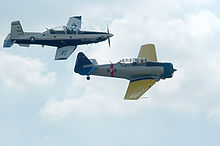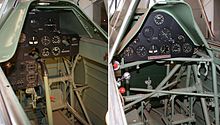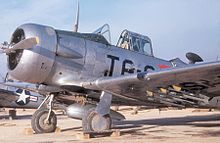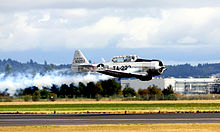- North American T-6 Texan
-
This article is about the first T-6 Texan. For the newer Beech aircraft, see T-6 Texan II.
T-6 Texan/SNJ/Harvard USAAF AT-6Cs near Luke Field, 1943 Role Trainer aircraft Manufacturer North American Aviation First flight 1 April 1935 Primary users United States Army Air Forces
United States Navy
Royal Air ForceNumber built 15,495 Developed from North American NA-16 Variants North American A-27 An original T-6 Texan aircraft (painted as a US Navy SNJ), right, with the new T-6 Texan II, left, at Randolph Air Force Base, Texas, in 2007
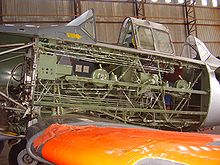 A South African Air Force Harvard under restoration exposing internal structure
A South African Air Force Harvard under restoration exposing internal structure
The North American Aviation T-6 Texan was a single-engine advanced trainer aircraft used to train pilots of the United States Army Air Forces, United States Navy, Royal Air Force and other air forces of the British Commonwealth during World War II and into the 1950s. Designed by North American Aviation, the T-6 is known by a variety of designations depending on the model and operating air force. The USAAC designated it as the "AT-6", the US Navy the "SNJ", and British Commonwealth air forces, the Harvard, the name it is best known by outside of the United States. It remains a popular warbird aircraft.
Contents
Development
The Texan originated from the North American NA-16 prototype (first flown on April 1, 1935) which, modified as the NA-26, was submitted as an entry for a USAAC "Basic Combat" aircraft competition in March, 1937. The first model went in to production and 180 were supplied to the USAAC as the BC-1 and 400 to the RAF as the Harvard I. The US Navy received 16 modified aircraft, designated the SNJ-1, and a further 61 as the SNJ-2 with a different engine.
The BC-1 was the production version of the NA-26 prototype, with retractable tailwheel landing gear and the provision for armament, a two-way radio, and the 550 hp (410 kW) R-1340-47 engine as standard equipment. Production versions included the BC-1 (Model NA-36) with only minor modifications (177 built), of which 30 were modified as BC-1I instrument trainers; the BC-1A (NA-55) with airframe revisions (92 built); and a single BC-1B with a modified wing center-section.
Three BC-2 aircraft were built before the shift to the "advanced trainer" designation, AT-6, which was equivalent to the BC-1A. The differences between the AT-6 and the BC-1 were new outer wing panels with a swept forward trailing edge, squared-off wingtips and a triangular rudder, producing the definitive Texan appearance. After a change to the rear of the canopy, the AT-6 was designated the Harvard II for RAF/RCAF orders and 1,173 were supplied by purchase or Lend Lease, mostly operating in Canada as part of the British Commonwealth Air Training Plan.
Next came the AT-6A which was based on the NA-77 design and was powered by the Pratt & Whitney R-1340-49 Wasp radial engine. The USAAF received 1,549 and the US Navy 270 (as the SNJ-3). The AT-6B was built for gunnery training and could mount a .30 in machine gun on the forward fuselage. It used the R-1340-AN-1 engine, which was to become the standard for the remaining T-6 production. Canada's Noorduyn Aviation built an R-1340-AN-1-powered version of the AT-6A, which was supplied to the USAAF as the AT-16 (1,500 aircraft) and the RAF/RCAF as the Harvard IIB (2,485 aircraft), some of which also served with the Fleet Air Arm and Royal Canadian Navy.
In late 1937 Mitsubushi purchased two NA-16s as technology demonstrators and possibly a licence to build more. However, the aircraft developed by Watanabe/Kyushu as the K10W1 (Allied code name Oak) bore no more than a superficial resemblance to the North American design. It featured a full monocoque fuselage as opposed to the steel tube fuselage of the T-6 and NA-16 family of aircraft, as well as being of smaller dimensions overall and had no design details in common with the T-6. It was used in very small numbers by the Imperial Japanese Navy from 1942 onwards. After the war the Japanese Air Self Defense Force operated Texans.
The NA-88 design resulted in 2,970 AT-6C Texans and 2,400 as the SNJ-4. The RAF received 726 of the AT-6C as the Harvard IIA. Modifications to the electrical system produced the AT-6D (3,713 produced) and SNJ-5 (1,357 produced). The AT-6D, redesignated the Harvard III, was supplied to the RAF (351 aircraft) and Fleet Air Arm (564 aircraft). The AT-6G (SNJ-5) involved major advancements including a full-time hydraulic system and a steerable tailwheel and persisted into the 1950s as the USAF advanced trainer.
Subsequently the NA-121 design with a completely clear rearmost section on the canopy, gave rise to 25 AT-6F Texans for the USAAF and 931, as the SNJ-6 for the US Navy. The ultimate version, the Harvard 4, was produced by Canada Car and Foundry during the 1950s, and supplied to the RCAF, USAF and Bundeswehr.
A total of 15,495 T-6s of all variants were built.
Combat use
During the Korean War and, to a lesser extent, the Vietnam War, T-6s were pressed into service as forward air control aircraft. These aircraft were designated T-6 "Mosquitos".[1] No. 1340 Flight RAF used the Harvard in Kenya against the Mau Mau in the 1950s, where they operated with 20 lb bombs and machine guns against the gangs. Some operations took place at altitudes around 20,000 ft above mean sea level. A Harvard was the longest-serving RAF aeroplane, with an example, taken on strength in 1945, still serving in the 1990s (as a chase plane for helicopter test flights—a role for which the Shorts Tucano's high stall speed was ill-suited). The T-6G was also used in a light attack or counter insurgency role by France during the Algerian war in special Escadrilles d'Aviation Légère d'Appui (EALA), armed with machine guns, bombs and rockets. At its peak, there were 38 EALAs active. The largest unit was the Groupe d'Aviation Légère d'Appui 72, which consisted of up to 21 EALAs. From 1961 to 1975, Portugal, also, used hundreds of T-6G in the counter insurgency role during the Portuguese Colonial War. During this war, almost all the Portuguese Air Force bases and air fields in Angola, Mozambique and Portuguese Guinea had a detachment of T-6Gs. In 1957-58, the Spanish Air Force used T-6 as counterinsurgency aircraft in the Ifni War, armed with machine guns, iron bombs and rockets, achieving an excellent reputation due to its reliability, safety record and resistance to damage. Pakistan Air Force use T-6Gs in 1971 war as a night ground support aircraft hitting enemy soft transport vehicles.In the early hours of 5 December, during a convoy interdiction mission in the same area, Squadron Leader Israr Quresh's T-6G Harvard was hit by enemy ground fire and a shell fractured the pilot’s right arm. Profusely bleeding, the pilot flew the aircraft back with his left hand and landed safely. The World War II vintage prop-engined trainers were pressed into service and performed satisfactorily in the assigned role of enemy convoys at night.
Since the Second World War, the T-6 has been a regular participant at air shows, and was used in many movies. For example, in Tora! Tora! Tora! and The Final Countdown, converted single-seat T-6s painted in Japanese markings represent Mitsubishi Zeroes, whereas in A Bridge too Far it represented the razorback Republic P-47 Thunderbolt. The T-6 also appeared in the Pat Benatar video for Shadows of the Night. The New Zealand Warbirds "Roaring 40s" aerobatic team use ex-Royal New Zealand Air Force Harvards. The Reno National Air Races also has a class specifically for the T-6 during the National Air Races each year.
Mainly as a result of the United Nations arms embargo against South Africa's Apartheid policies, T-6s remained in service with the South African Air Force as a basic trainer until 1995, when they were replaced by Pilatus PC-7MkII turboprop trainers.[2]
Variants
Main article: North American T-6 Texan variantsOperators
 WAVES washing an SNJ at NAS Jacksonville, FL.
WAVES washing an SNJ at NAS Jacksonville, FL.
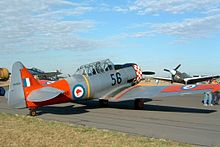 AT-6C Harvard IIA in RNZAF markings
AT-6C Harvard IIA in RNZAF markings T-6G in Portuguese Air Force museum
T-6G in Portuguese Air Force museum
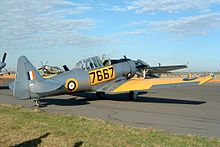 SNJ-4 Texan in South African Air Force WW2 era markings
SNJ-4 Texan in South African Air Force WW2 era markings
 RNZAF North American Harvards at Onerahi Aerodrome, near Whangarei, New Zealand in 1961.
RNZAF North American Harvards at Onerahi Aerodrome, near Whangarei, New Zealand in 1961.
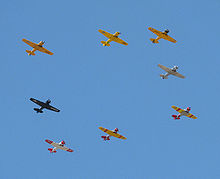 Formation flying at the Commemorative Air Force Airsho 2008
Formation flying at the Commemorative Air Force Airsho 2008
- Argentine Naval Aviation
- Air Force of El Salvador
- Armed Forces of Haiti
- Indonesian Air Force - ex-Dutch aircraft.
- Iranian Air Force
- Royal Laotian Air Force
- Royal Netherlands Air Force
- Dutch Naval Aviation Service
- Royal Netherlands East Indies Army Air Force - Post war
 Norway - 1 maintained for historic flight
Norway - 1 maintained for historic flight
- Paraguayan Air Force
- Paraguayan Naval Aviation
- Southern Rhodesian Air Force
- Turkish Air Force: 196 planes of various types
- United States Army Air Corps/Army Air Forces
- United States Air Force
- United States Navy
- United States Marine Corps
- United States Coast Guard
Specifications (T-6G)
Data from Jane’s Fighting Aircraft of World War II[3]
General characteristics
- Crew: two (student and instructor)
- Length: 29 ft (8.84 m)
- Wingspan: 42 ft (12.81 m)
- Height: 11 ft 8 in (3.57 m)
- Wing area: 253.7 ft² (23.6 m²)
- Empty weight: 4,158 lb (1,886 kg)
- Loaded weight: 5,617 lb (2,548 kg)
- Powerplant: 1 × Pratt & Whitney R-1340-AN-1 Wasp radial engine, 600 hp (450 kW)
Performance
- Maximum speed: 208 mph at 5,000 ft (335 km/h at 1,500 m)
- Cruise speed: 145 mph (233 km/h)
- Range: 730 miles (1,175 km)
- Service ceiling: 24,200 ft (7,400 m)
- Rate of climb: ft/min (m/s)
- Wing loading: 22.2 lb/ft² (kg/m²)
- Power/mass: 0.11 hp/lb (kW/kg)
Armament
- Provision for up to 3× 0.30 in (7.62 mm) machine gun
See also
- Related development
- North American NA-16
- North American BT-9
- North American BC-1
- North American A-27
- North American P-64
- CAC Wirraway
- I.Ae. D.L. 22
- Aircraft of comparable role, configuration and era
- Miles Master
- Kyushu K10W
- Fiat G.49
- Arado Ar 96
- Related lists
- List of military aircraft of the United States
- List of military aircraft of the United States (naval)
- List of aircraft of the RAF
- List of aircraft of the RNZAF
- T-6 Texan variants
References
Notes
- ^ AF Museum - North American T-6D "Mosquito"
- ^ http://www.af.mil.za/about_us/history.html#7
- ^ Bridgeman, Leonard. “The North American Texan.” Jane's Fighting Aircraft of World War II. London: Studio, 1946.. p. 251. ISBN 1 85170 493 0.
Bibliography
- Becker, Dave and Brent, Winston. AT-6 Harvard in South African Service (African Aviation Series No.1). Nelspruit, South Africa:, Freeworld Publications CC, 2000. ISBN 0-95838-802-4.
- Bergése, Francis. North American T-6 (in French). Rennes, France: Ouest France, 1979. ISBN 2-85882-183-6.
- Davis, Larry. T-6 Texan in Action (Aircraft Number 94). Carrollton, TX: Squadron/Signal Publications, Inc., 1989. ISBN 0-89747-224-1.
- Donald, David. American Warplanes of World War II. London:Aerospace Publishing, 1995. ISBN 1 874023 72 7.
- Fletcher, David C. and MacPhail, Doug. Harvard! the North American Trainers in Canada. San Josef,BC/Dundee,Ont: DCF Flying Books, 1990. ISBN 0-96938-250-2.
- Hagedorn, Dan. North American NA-16/AT-6/SNJ (WarbirdTech Volume 11). North Branch, MN: Speciality Press, 1997. ISBN 0-93342-476-0.
- Hamlin, John F. The Harvard File. Tonbridge, Kent, UK: Air-Britain (Historians) Ltd., 1988. ISBN 0-85130-160-6.
- Jesse. William. T-6 Texan, the Immortal Pilot Trainer. London: Osprey Publishing Ltd., 1991. ISBN 1-85532-154-8.
- Kohn, Leo J. The Story of the Texan (American Flight Manuals). Aviation Publications Co., 1975. ISBN 0-87994-034-4.
- MacPhail, Doug and Östberg, Mikael. Triple Crown BT-9: The ASJA/Saab Sk 14, A Pictorial Essay (in English/Swedish). San Josef,BC/Dundee,Ont: DCF Flying Books, 2003.
- Marchand, Patrick and Takamori, Junko. North American T-6 et derives (in French). Le Muy, France: Editions d’Along, 2004. ISBN 2-914403-21-6.
- Morgan, Len. Famous Aircraft Series: The AT-6 Harvard. New York: Arco Publishing Co., Inc., 1965.
- Olrich, Walter and Ethell, Jeffrey L. Pilot maker; the Incredible T-6. North Branch, MN: Specialty Press, 1982. ISBN 0-93342-434-5.
- Smith, Peter Charles. North American T-6: SNJ, Harvard and Wirraway. Ramsbury, Marlborough, Wiltshire, UK: The Crowood Press Ltd., 2000. ISBN 1-86126-382-1.
- Smith, Peter Charles. T-6: The Harvard, Texan & Wirraway - A Pictorial Record. North Branch, MN: Speciality Press, 1995. ISBN 0-7603-0191-3.
- Spring, Ivan and Rivers, Reg. Colour schemes and special markings of the North American "Harvard" in service with the SAAF 1940 to 1995. Pretoria, SOuth Africa: Spring Air Publishers, 1996. ISBN 0-9583977-3-2.
- Starkings, Peter. From American Acorn to Japanese Oak - The tale of an unsung Japanese training aircraft with roots extending across the Pacific Ocean. Arawasi International, Asahi Process, September-December 2007, Issue 7.
- Swanborough, Gordon and Bowers, Peter M. United States Military Aircraft since 1909. London:Putnam, 1963.
- Wache, Siegfried. CCF Harvard Mk. IV (T-6) (series F-40 - Die Flugzeuge der Bundeswehr Nr.09) (in German). Buchholz, Germany: Buchholz Medien Verlag, 1989. ISBN 3-935761-09-0.
External links
- The Canadian Harvard Aircraft Association
- Backgrounder on the Harvard 4 (includes photographs)
- AT-6: School Marm With an Attitude (pilot report)
- Warbird Alley: T-6/SNJ/Harvard page - History, photos, specs, and links
- "A Yank at Grantham: First North American "Basic" Trainer Delivered to the R.A.F. : The Harvard Described Flight 1939
Articles and topics related to the T-6 Texan North American Aviation and North American Aviation division of Rockwell International Aircraft Manufacturer
"Charge Number"NA-15 · NA-16 · NA-17 (components) · NA-18 · NA-19 · NA-20 · NA-21 · NA-22 · NA-23 · NA-24 (components) · NA-25 · NA-26 · NA-27 · NA-28 · NA-29 · NA-30 · NA-31 · NA-32 · NA-33 · NA-34 · NA-35 · NA-36 · NA-37 · NA-38 · NA-39 · NA-40 · NA-41 · NA-42 · NA-43 · NA-44 · NA-45 · NA-46 · NA-47 · NA-48 · NA-49 · NA-50 · NA-51 · NA-52 · NA-53 · NA-54 · NA-55 · NA-56 · NA-57 · NA-58 · NA-59 · NA-60 · NA-60 · NA-61 · NA-62 · NA-63 · NA-64 · NA-65 · NA-66 · NA-67 · NA-68 · NA-69 · NA-70 · NA-71 · NA-72 · NA-73 · NA-73 · NA-74 · NA-75 · NA-76 · NA-77 · NA-78 · NA-79 · NA-81 · NA-82 · NA-83 · NA-84 · NA-85 · NA-87 · NA-88 · NA-89 · NA-90 · NA-91 · NA-92 · NA-93 · NA-94 · NA-95 · NA-96 · NA-97 · NA-98 · NA-99 · NA-100
NA-101 · NA-102 · NA-103 · NA-104 · NA-105 · NA-106 · NA-107 · NA-108 · NA-109 · NA-110 · NA-111 · NA-112 · NA-113 · NA-114 · NA-115 · NA-116 · NA-117 · NA-118 · NA-119 · NA-120 · NA-121 · NA-122 · NA-123 · NA-124 · NA-125 · NA-126 · NA-127 · NA-128 · NA-129 · NA-130 · NA-132 · NA-134 · NA-135 · NA-137 · NA-138 · NA-139 · NA-140 · NA-141 · NA-142 · NA-143 · NA-144 · NA-145 · NA-146 · NA-147 · NA-148 · NA-149 · NA-150 · NA-151 · NA-152 · NA-153 · NA-154 · NA-155 · NA-156 · NA-157 · NA-158 · NA-159 · NA-160 · NA-161 · NA-162 · NA-163 · NA-164 · NA-165 · NA-166 · NA-167 · NA-168 · NA-169 · NA-170 · NA-171 · NA-172 · NA-173 · NA-174 · NA-175 · NA-176 · NA-177 · NA-178 · NA-179 · NA-180 · NA-181 · NA-182 · NA-183 · NA-184 · NA-185 · NA-186 · NA-187 · NA-188 · NA-189 · NA-190 · NA-191 · NA-192 · NA-193 · NA-194 · NA-195 · NA-196 · NA-197 · NA-198 · NA-199 · NA-200
NA-201 · NA-202 · NA-203 · NA-204 · NA-205 · NA-206 · NA-207 · NA-208 · NA-209 · NA-210 · NA-211 · NA-212 · NA-213 · NA-214 · NA-215 · NA-216 · NA-217 · NA-218 · NA-219 · NA-220 · NA-221 · NA-222 · NA-223 · NA-224 · NA-225 · NA-226 · NA-227 · NA-228 · NA-229 · NA-230 · NA-231 · NA-232 · NA-233 · NA-234 · NA-235 · NA-236 · NA-237 · NA-238 · NA-239 · NA-240 · NA-241 · NA-242 · NA-243 · NA-244 · NA-245 · NA-246 · NA-247 · NA-248 · NA-249 · NA-251 · NA-252 · NA-253 · NA-254 · NA-255 · NA-256 · NA-257 · NA-258 · NA-259 · NA-260 · NA-261 · NA-262 · NA-263 · NA-264 · NA-265 · NA-266 · NA-267 · NA-268 · NA-269 · NA-270 · NA-271 · NA-272 · NA-273 · NA-274 · NA-275 · NA-276 · NA-277 · NA-278 · NA-279 · NA-280 · NA-281 · NA-282 · NA-283 · NA-284 · NA-285 · NA-286 · NA-287 · NA-288 · NA-289 · NA-290 · NA-291 · NA-292 · NA-293 · NA-294 · NA-295 · NA-296 · NA-297 · NA-298 · NA-299 · NA-300
NA-301 · NA-302 · NA-303 · NA-304 · NA-305 · NA-306 · NA-307 · NA-308 · NA-309 · NA-310 · NA-311 · NA-312 · NA-313 · NA-314 · NA-315 · NA-316 · NA-317 · NA-318 · NA-319 · NA-320 · NA-321 · NA-322 · NA-323 · NA-324 · NA-325 · NA-326 · NA-327 · NA-328 · NA-329 · NA-330 · NA-331 · NA-332 · NA-333 · NA-334 · NA-336 · NA-337 · NA-338 · NA-340 · NA-341 · NA-342 · NA-343 · NA-344 · NA-345 · NA-346 · NA-347 · NA-348 · NA-349 · NA-350 · NA-351 · NA-352 · NA-353 · NA-354 · NA-356 · NA-357 · NA-358 · NA-359 · NA-360 · NA-361 · NA-362 · NA-363 · NA-364 · NA-365 · NA-366 · NA-367 · NA-369 · NA-370 · NA-371 · NA-372 · NA-373 · NA-374 · NA-375 · NA-376 · NA-377 · NA-378 · NA-379 · NA-380 · NA-382 · NA-383 · NA-384 · NA-385 · NA-386 · NA-387 · NA-388 · NA-389 · NA-390 · NA-391 · NA-392 · NA-393 · NA-394 · NA-395 · NA-396 · NA-397 · NA-398 · NA-300 · NA-400 · NA-401 · NA-402 · NA-403 · NA-404 · NA-405 · NA-406 · NA-407 · NA-420 · NA-430 · NA-431By role Fighters: P-51 · P-64 · F-82 · FJ-1 · FJ-2/3 · FJ-4 · F-86/F-86D · YF-93 · F-100 · F-107 · F-108 · XFV-12
Bombers: XB-21 · B-25 · XB-28 · B-45 · XB-70 · B-1
Observation: O-47 · OV-10
Attack aircraft: A-27 · A-36 · AJ · A2J · A3J/A-5
Trainers: BT-9 · BC-1 · BC-2 · T-6 · SN2J · T-28 · T-39 · T-2
Experimental: X-15
Business aircraft: Sabreliner
Missiles: AGM-28 · MQM-42 · AGM-53
Licence production: B-24 · C-82By name USN scout aircraft designations Scout Dayton-WrightSDWSEGreat LakesSL • S2L
SikorskySSScout Bomber SBA • SB2A
XSBFGreat LakesSBGSBTSBU • SB2U • XSB3U
Canadian Car & FoundryScout Observation SOEEdo AircraftSO2ESOKRyan(SOU not allocated) • XSO2U
Scout Trainer SNJ • XSN2J
SNVUSAAC/USAAF/USAF/Tri-service trainer aircraft Advanced Trainer Basic Combat BC-1 · BC-2 · BC-3
Basic Trainer Primary Trainer (1924-1948) Trainer (1948-1990) "T-1", "T-2", "T-3" and "T-6" have also been assigned since 1962 in a separate sequence. USN/USMC trainer aircraft designations 1948–1962 Edo Grumman North American Lockheed Temco Lockheed Flygvapnet trainer aircraft designations pre-1940 Swedish Air Force military aircraft designations 1940–present B/S/T/Tp 16 - Sk 16 • B/S 17 • B/S/T 18 • J 19 • J 20 • A/J 21 • J/S 22 • J 23 • B/J 24 - Tp 24 • Sk 25 • Sk 26 - B/S 26 - J/S 26 • J 27 • A/J/Sk 28 • A/J/S 29 • J 30 • S 31 • A/J/S 32 • J 33 • J 34 • J/S/Sk 35 • A 36 • AJ/JA 37 • A/Sk 38 • JAS 39 • Tp 45 • Tp 46 • Tp 47 • Sk 50 • Fpl 51 • Tp 52 • Tp 53 • Fpl 54 - Tp 54 • Tp 55 • Sk 60 • Sk/Fpl 61 • Tp 78 • Tp 79 • Tp 80 • Tp 81 • Tp 82 • Tp 83 • Tp 84 • Tp 85 • Tp 86 • Tp 87 • Tp 88 • Tp 89 • Tp 91 • Tp 100 • Tp 101 • Tp 102 • Tp 103
Lists relating to aviation General Aircraft (manufacturers) · Aircraft engines (manufacturers) · Airlines (defunct) · Airports · Civil authorities · Museums · Registration prefixes · Rotorcraft (manufacturers) · TimelineMilitary Accidents/incidents Records Categories:- Military aircraft of the Korean War
- North American Aviation aircraft
- United States military trainer aircraft 1930–1939
- World War II trainer aircraft of the United States
Wikimedia Foundation. 2010.


